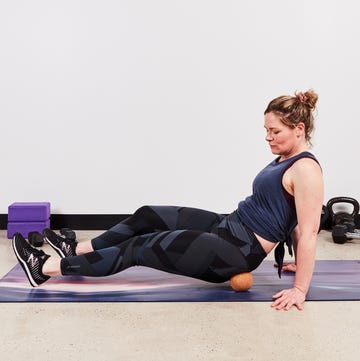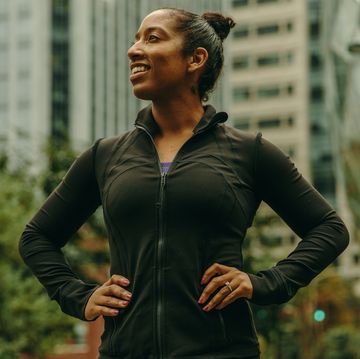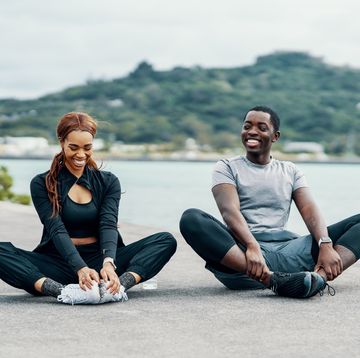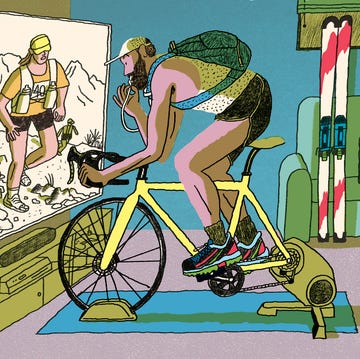Over the last few days, I got pulled into a debate on Twitter on a hot-button topic. The IAAF recently announced that, starting in 2017, senior men and women will run the same distance—10K—at the World Cross Country Championships. Currently, the men run 12K and the women run 8K.
In the debate that followed, one of the arguments advanced by elite runner Lauren Fleshman for keeping women’s distances shorter (at least at developmental stages like university racing) was that “women reach endurance peak later.” This is an idea that got talked about a bunch after the 2008 Olympic marathons, which were won by 38-year-old Constantina Tomescu-Dita and 21-year-old Sammy Wanjiru. But was that indicative of a pattern, or just an aberration?
As it happens, Sandra Hunter and her colleagues at Marquette University decided to investigate that very question, publishing their results in Medicine and Science in Sports and Exercise in 2011. They looked at a decade or two (depending on availability) of results from the Berlin, Boston, Chicago, London, and New York Marathons, plus the Olympic and World Championship marathons. They found no discernible pattern or trend in the age of top-five finishers. They wrote: “These data indicate that men and women physiologically peak at a similar age in marathon running performance.”
Still, Fleshman pointed out—correctly—that a single example doesn’t prove the case. She looked at the age of finalists from the 2013 World Championships over 5,000 and 10,000 meters and found that the women were older than the men (27.6 versus 25.9 in the 10,000). The difference seemed particularly pronounced in “non-African trained” runners, suggesting that the sex differences may also be affected by race.
Is this possible? Sure. A ridiculous proportion of physiology research has historically used male subjects, but scientists like Hunter are helping change that—and it’s clear that men and women do have significant physiological differences. Hunter gave a keynote talk on sex differences in fatigue at the ACSM conference this spring, and the message I took away was: Yes, there are differences, but they’re subtle and highly context-dependent.
One problem with looking at the average age of top performers is that it potentially conflates cause and effect. If women do indeed peak at longer distances when they’re older, is this because they’re physiologically destined to (and thus it makes sense to have them run shorter distances in college)? Or does the fact that women currently run shorter distances when they’re younger mean that they wait longer to eventually move up and master longer distances like the 10,000 meters and marathon?
Similarly, some elite women take time away from competition to have children. This could, in theory, shorten their careers if a majority don’t return to high level competition, thus pushing the average age younger. Or it could extend their careers, giving their legs a break so they’re better able to continue training into their 30s. The numbers, on their own, can’t tell if either of these factors are at work.
One proposition we can test a little more carefully is the idea that women peak later at longer events in particular, by comparing the age profiles at different distances. That’s what I decided to do: I took the top 100 performers from 2013 (the same year that Lauren analyzed) in events from 100 meters to the marathon. Here are the average ages for men and women, along with the standard deviation:
It’s possible to argue this data in several different ways. It’s true, as it turns out, that the women are older than the men in the 10,000 and marathon. But the differences are tiny relative to the standard deviations. Moreover, the women are older than the men by a similar margin in the 400 meters, and the gap is smallest at 5000 meters. It’s certainly not definitive, but I find it hard to see any clear endurance-age pattern here—certainly not clear enough to be a basis for prescribing different distances to men and women.
It would be interesting to repeat this exercise for different years, to see how robust the patterns are. I’ll leave that for another time, but here’s a look back at some data compiled by David Martin and Peter Coe in their classic book, Better Training for Distance Runners. They compiled the average ages of the top 10 performers of all time as of 1996. Here’s what they found:
Distance / Men / Women
800 / 24.2 / 25.1
1500 / 26.3 / 26.2
3000 / 24.9 / 24.7
5000 / 25.0 / 24.9
10000 / 24.5 / 25.0
Mar / 29.3 / 26.8
At that time, then, women seemed to reach their endurance peak earlier than men. That’s sociology, not physiology—and it’s a reminder of why we should take this kind of data with a grain of salt.
Of course, the question of when women reach their endurance peak is a very minor sideline to the main point. The stronger arguments for keeping women’s distances shorter relate to the risks of overtraining and eating disorders. I understand these arguments, but I’ll be totally honest: they’re no more convincing to me than if the same arguments were deployed to decide that college women should no longer be allowed to run 10,000 meters on the track. I’m by no means an advocate of teen marathoners, and in most cases I wouldn’t encourage young runners to move up to 10,000 meters too soon either—but those considerations don’t seem to me to be fundamentally different for men and women.
(It’s also worth noting that the changes to the World Cross Country Championships only apply to senior athletes, who are 20 and older. Junior women will still run 6K, while junior men will run 8K.)
In the end, I look at it this way: if we were creating a new sport, one that involved racing over hill and dale and across the countryside, there’s simply no way we’d arbitrarily decide to make the race shorter for women than men. The only reason we’re stuck in that rut is because of the powerful forces of status quo bias. In a decade, we’ll have mercifully forgotten that this was even a debate.
* * *
Read the Sweat Science book, and follow the latest posts via Twitter, Facebook, or occasional email digest.














